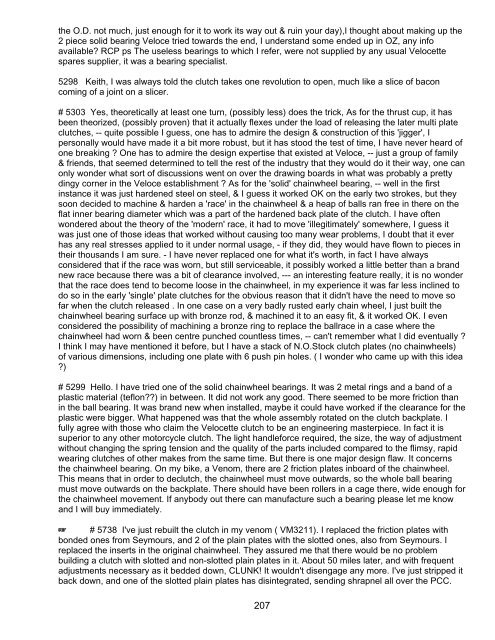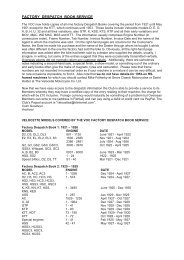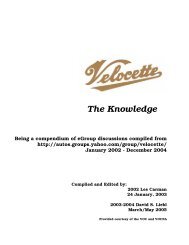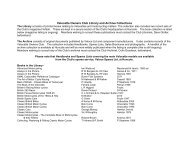The Knowledge - Velocette Owners Club
The Knowledge - Velocette Owners Club
The Knowledge - Velocette Owners Club
You also want an ePaper? Increase the reach of your titles
YUMPU automatically turns print PDFs into web optimized ePapers that Google loves.
the O.D. not much, just enough for it to work its way out & ruin your day),I thought about making up the<br />
2 piece solid bearing Veloce tried towards the end, I understand some ended up in OZ, any info<br />
available? RCP ps <strong>The</strong> useless bearings to which I refer, were not supplied by any usual <strong>Velocette</strong><br />
spares supplier, it was a bearing specialist.<br />
5298 Keith, I was always told the clutch takes one revolution to open, much like a slice of bacon<br />
coming of a joint on a slicer.<br />
# 5303 Yes, theoretically at least one turn, (possibly less) does the trick, As for the thrust cup, it has<br />
been theorized, (possibly proven) that it actually flexes under the load of releasing the later multi plate<br />
clutches, -- quite possible I guess, one has to admire the design & construction of this 'jigger', I<br />
personally would have made it a bit more robust, but it has stood the test of time, I have never heard of<br />
one breaking ? One has to admire the design expertise that existed at Veloce, -- just a group of family<br />
& friends, that seemed determined to tell the rest of the industry that they would do it their way, one can<br />
only wonder what sort of discussions went on over the drawing boards in what was probably a pretty<br />
dingy corner in the Veloce establishment ? As for the 'solid' chainwheel bearing, -- well in the first<br />
instance it was just hardened steel on steel, & I guess it worked OK on the early two strokes, but they<br />
soon decided to machine & harden a 'race' in the chainwheel & a heap of balls ran free in there on the<br />
flat inner bearing diameter which was a part of the hardened back plate of the clutch. I have often<br />
wondered about the theory of the 'modern' race, it had to move 'illegitimately' somewhere, I guess it<br />
was just one of those ideas that worked without causing too many wear problems, I doubt that it ever<br />
has any real stresses applied to it under normal usage, - if they did, they would have flown to pieces in<br />
their thousands I am sure. - I have never replaced one for what it's worth, in fact I have always<br />
considered that if the race was worn, but still serviceable, it possibly worked a little better than a brand<br />
new race because there was a bit of clearance involved, --- an interesting feature really, it is no wonder<br />
that the race does tend to become loose in the chainwheel, in my experience it was far less inclined to<br />
do so in the early 'single' plate clutches for the obvious reason that it didn't have the need to move so<br />
far when the clutch released . In one case on a very badly rusted early chain wheel, I just built the<br />
chainwheel bearing surface up with bronze rod, & machined it to an easy fit, & it worked OK. I even<br />
considered the possibility of machining a bronze ring to replace the ballrace in a case where the<br />
chainwheel had worn & been centre punched countless times, -- can't remember what I did eventually ?<br />
I think I may have mentioned it before, but I have a stack of N.O.Stock clutch plates (no chainwheels)<br />
of various dimensions, including one plate with 6 push pin holes. ( I wonder who came up with this idea<br />
?)<br />
# 5299 Hello. I have tried one of the solid chainwheel bearings. It was 2 metal rings and a band of a<br />
plastic material (teflon??) in between. It did not work any good. <strong>The</strong>re seemed to be more friction than<br />
in the ball bearing. It was brand new when installed, maybe it could have worked if the clearance for the<br />
plastic were bigger. What happened was that the whole assembly rotated on the clutch backplate. I<br />
fully agree with those who claim the <strong>Velocette</strong> clutch to be an engineering masterpiece. In fact it is<br />
superior to any other motorcycle clutch. <strong>The</strong> light handleforce required, the size, the way of adjustment<br />
without changing the spring tension and the quality of the parts included compared to the flimsy, rapid<br />
wearing clutches of other makes from the same time. But there is one major design flaw. It concerns<br />
the chainwheel bearing. On my bike, a Venom, there are 2 friction plates inboard of the chainwheel.<br />
This means that in order to declutch, the chainwheel must move outwards, so the whole ball bearing<br />
must move outwards on the backplate. <strong>The</strong>re should have been rollers in a cage there, wide enough for<br />
the chainwheel movement. If anybody out there can manufacture such a bearing please let me know<br />
and I will buy immediately.<br />
L # 5738 I've just rebuilt the clutch in my venom ( VM3211). I replaced the friction plates with<br />
bonded ones from Seymours, and 2 of the plain plates with the slotted ones, also from Seymours. I<br />
replaced the inserts in the original chainwheel. <strong>The</strong>y assured me that there would be no problem<br />
building a clutch with slotted and non-slotted plain plates in it. About 50 miles later, and with frequent<br />
adjustments necessary as it bedded down, CLUNK! It wouldn't disengage any more. I've just stripped it<br />
back down, and one of the slotted plain plates has disintegrated, sending shrapnel all over the PCC.<br />
207





